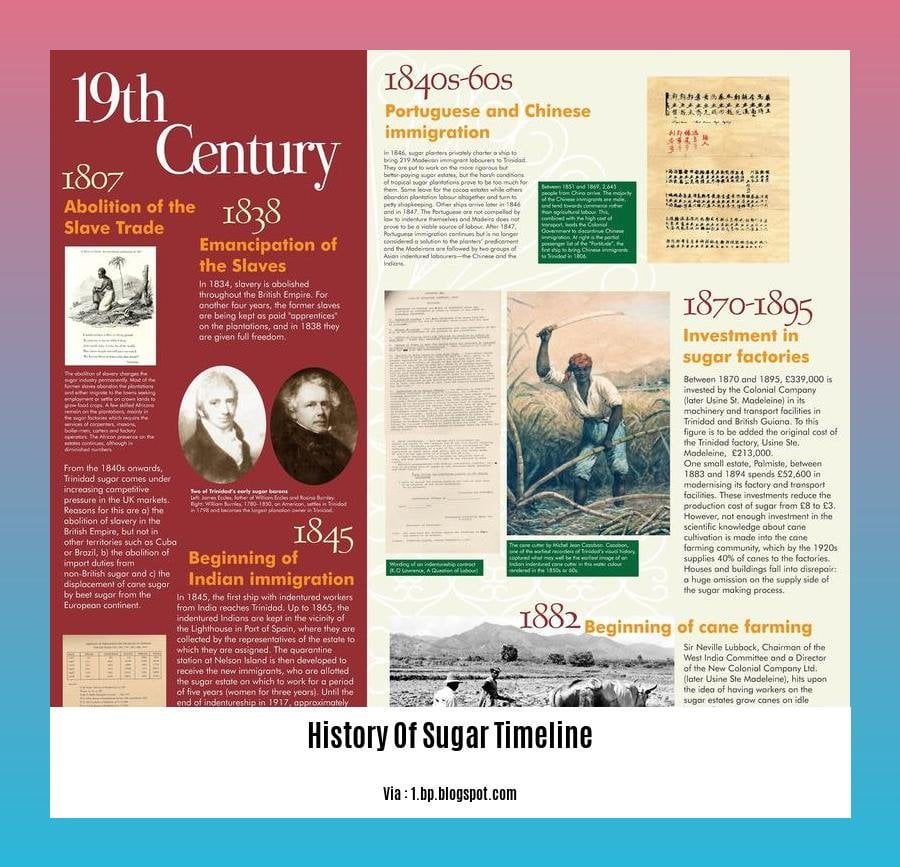Embark on a historical odyssey through the fascinating timeline of sugar, a commodity that has shaped civilizations and continues to influence global economies. From its ancient origins to its current status as a culinary staple and industrial powerhouse, sugar’s journey has left an indelible mark on human history. Join us as we uncover the secrets of this versatile substance and explore how it has sweetened our lives, influenced cultural traditions, and transformed societies throughout the ages in our article titled [A Journey Through Time: Exploring the History of Sugar’s Legacy].
Key Takeaways:
- Sugarcane was first domesticated in India and Southeast Asia in 8000 BCE.
- Indian manufacturers began making cooled sugar syrup around 500 BCE.
- Sugar production spread throughout the world, reaching Europe via the Middle East and Asia during the Crusades.
- Europeans introduced sugarcane to the New World in the 1490s, leading to the establishment of sugar plantations in the Caribbean and South America.
- Sugar was considered so valuable in the past that it was kept under lock and key.
History of Sugar Timeline

Imagine sugar, a ubiquitous part of our culinary world, as a narrative that unfolds over centuries – a tale of journeys, transformations, and profound historical imprints. So, buckle up for a sweet journey through time as we trace the history of sugar timeline.
Origins in the East: The Seeds of Sweetness
The sugar story begins in tropical India and Southeast Asia, around 8000 BCE. Here, sugarcane, the sugar-bearing grass, was first domesticated, its potential as a source of sweetness recognized. Indian manufacturers took it a step further, creating cooled sugar syrup around 500 BCE, a pivotal step in sugar’s evolution.
Medieval Sweeteners: A Taste of Luxury
Sugar’s journey took a significant turn in the Middle Ages. During the Crusades, Europeans encountered this exotic substance, bringing it back to their homelands. Sugar became a prized commodity, a luxury reserved for the wealthy and influential, its value reflected in the elaborate sugar banquets of the time.
The Americas and Sugar: A New Chapter
The arrival of Europeans in the Americas opened a new chapter in the history of sugar timeline. They introduced sugarcane to the New World, establishing profitable plantations in the Caribbean and South America. The lucrative sugar trade fueled the rise of the trans-Atlantic slave trade, leaving a dark stain on sugar’s legacy.
Global Expansion and Accessibility
With the rise of the sugar industry, sugar’s availability expanded dramatically. The establishment of sugar plantations in tropical regions, coupled with improved refining techniques, made sugar more accessible to people worldwide. It became a staple in households, a key ingredient in sweet treats, and an essential part of our culinary heritage.
Sugar’s Impact on Society: A Bittersweet Legacy
Sugar’s journey through time has been entwined with our social and economic history. On one hand, it brought joy and sweetness to our palates, serving as a source of energy and a symbol of luxury. On the other hand, the sugar industry’s involvement in the slave trade and its contribution to modern-day health concerns create a complex and bittersweet legacy.
Embracing Sustainable Sweetness
As we move forward, the story of sugar continues to evolve. The demand for sustainable and ethical sugar production has spurred the growth of fair trade and organic sugar initiatives. Consumers are now more aware of the social and environmental impact of their sugar choices, driving a shift towards responsible and sustainable practices in the sugar industry.
So, as you savor the sweetness of that next bite infused with this ancient commodity, remember the history of sugar timeline. It’s a story of exploration, innovation, global trade, and cultural transformation – a testament to humanity’s quest for sweetness through the ages.
History of Street Dance: Unravel the captivating tale of how this expressive art form evolved from the streets, shaping global culture with its electrifying moves and vibrant expressions. Learn more about the history of street dance.
History of Streetwear: Delve into the captivating evolution of streetwear, from its humble origins as a counter-culture movement to its current status as a global fashion phenomenon. Explore the intriguing history of streetwear.
History of Sufi Music: Immerse yourself in the rich tapestry of Sufi music, tracing its mystical origins and exploring how it has become a powerful force for spiritual enlightenment and cultural harmony. Discover the enthralling history of Sufi music.
Economic Impact and Imperialism: The Rise of the Sugar Industry

In our exploration of sugar’s legacy, we cannot ignore its economic impact and implications on imperialism. Sugar’s journey has been intertwined with power dynamics, wealth creation, and the darker aspects of colonial expansion. Let’s delve deeper into this fascinating chapter:
Sugar’s Sweet Profits:
- Imperial Cravings:
European powers, particularly Britain, fueled their insatiable demand for sugar through the establishment of vast sugar plantations in the Caribbean and South America.
Triangular Trade:
Sugar played a pivotal role in the infamous triangular trade routes. African slaves were forcibly brought to the Americas to work on sugar plantations, producing sugar for European markets.
Sweet Profits:
- Sugar became a highly lucrative commodity, generating enormous profits for plantation owners and merchants. The sugar trade fueled the rise of powerful trading companies and contributed significantly to the growth of colonial economies.
The Human Cost of Sugar’s Success:
- Enslaved Labor:
The labor-intensive nature of sugar cultivation led to the exploitation of enslaved Africans. They endured harsh working conditions, abuse, and a life of servitude to meet the growing demand for sugar.
Colonial Power Dynamics:
Sugar became a symbol of colonial power. European nations used their control over sugar production to assert their dominance and influence over colonized regions, leading to political and economic exploitation.
Legacy of Inequality:
- The legacy of sugar’s dark past still lingers. The exploitation and suffering endured by enslaved peoples in the sugar industry have left deep scars on societies that continue to struggle with issues of inequality and social justice.
Beyond the Economic:
- Imperial Influence:
Sugar’s economic significance extended beyond its monetary value. It influenced cultural exchange, culinary traditions, and the global flow of goods and ideas, shaping the societies it touched.
Technological Advancements:
- Sugar’s rise spurred technological innovations, including improved refining techniques and the development of new machinery, which had broader implications for industrialization.
Key Takeaways:
- The demand for sugar coincided with imperialism and the emergence of industrial societies.
- Sugar plantations in the Americas fueled by enslaved labor drove the triangular trade.
- Industrialization led to the mass production of refined sugar, making it affordable and popular.
- Sugar’s influence went beyond nutrition, shaping global politics, trade, labor, and technology.
- The legacy of sugar’s dark past persists in issues of inequality and social justice in societies touched by the industry.
Sources:
Technological Advancements: Innovations in Sugar Production
Sweetness entices our palates, and sugar has played a pivotal role in satisfying that craving throughout history. As we journey through sugar’s legacy, let’s explore the technological innovations that have transformed its production, allowing us to enjoy the sweet goodness we know today.
From ancient times, people sought ways to extract the sweetness from sugarcane. Early methods involved chewing the stalks to release the juice, which was then boiled down to form a crude form of sugar. As civilization progressed, so did our ability to refine sugar.
Centrifugal Force Revolutionizes Sugar Production
In the 19th century, the invention of the centrifugal force machine revolutionized sugar production. This machine used centrifugal force to separate sugar crystals from molasses, resulting in a purer and more refined product. The centrifugal force machine greatly increased the efficiency of sugar production, making it possible to produce sugar on a larger scale.
Mechanization Streamlines Sugar Harvesting
The mechanization of sugar harvesting and processing further revolutionized the industry. Before mechanization, sugarcane was harvested and processed by hand, a laborious and time-consuming process. The invention of mechanical harvesters and automated processing equipment streamlined these processes, reducing the need for manual labor and increasing efficiency.
Genetic Engineering and Biotechnology
Recent years have seen the advent of genetic engineering and biotechnology, opening up new possibilities for sugar production. Genetically modified sugarcane varieties can be developed to produce more sugar or to be resistant to pests and diseases. Biotechnology can also be used to develop enzymes that break down complex carbohydrates into simpler sugars, making it possible to produce sugar from a wider range of sources.
Key Takeaways:
- Technological innovations have revolutionized sugar production, from the centrifugal force machine to mechanization and genetic engineering.
- Increased efficiency and productivity have been achieved through these innovations, allowing for the mass production of sugar.
- Genetic engineering and biotechnology offer promising avenues for sustainable and efficient sugar production in the future.
Citations:
- Recent advance in technological innovations of sugar-reduced products
- What’s next in sugar reduction? Ingredient innovators weigh in
Social and Cultural Transformations: The Impact of Sugar on Societies
Over millennia, sugar has insinuated itself into the fabric of human experience, leaving an indelible imprint on societies and cultures worldwide. Its journey through time, from humble origins to a global commodity, mirrors a narrative of social and cultural transformations that have shaped our world.
From Status Symbol to Culinary Delight
Sugar’s story begins as a precious luxury reserved for the elite. In ancient times, it was a rare and costly commodity, often used as a sweetener in medicinal concoctions and as a token of wealth and status. As sugar production techniques advanced, it gradually made its way into various culinary delights, transforming the palates of cultures near and far.
The Bittersweet Saga of Sugar’s Global Impact
The global sugar trade, driven by European colonialism, brought sugar to the forefront of world commerce. Sugar plantations, often fueled by the exploitation of enslaved labor, sprang up in the Caribbean and South America, becoming a cornerstone of the trans-Atlantic economy. This bittersweet legacy of sugar has left a lasting impact on societies, highlighting the complex interplay between economic progress and social injustice.
Sugar’s Transformation of Global Cuisine
Sugar’s culinary influence is undeniable. It has revolutionized cooking, baking, and confectionery, adding sweetness and depth of flavor to dishes worldwide. From traditional Indian sweets to decadent European pastries, sugar has become an indispensable ingredient, inspiring culinary creativity and delighting taste buds across continents.
A Sweet Tooth with a Healthier Conscience
In contemporary times, sugar’s impact on society has taken a mindful turn. With growing awareness of its potential health implications, consumers are seeking healthier alternatives to traditional sugar. This has led to the rise of low-sugar and sugar-free products, as well as natural sweeteners derived from fruits and plants. This shift towards conscious consumption reflects a growing desire for a balanced and sustainable approach to sugar consumption.
Key Takeaways:
Sugar’s journey has been intertwined with social hierarchy, from a status symbol to a culinary staple.
The global sugar trade, fueled by colonialism and exploitation, has left a bittersweet legacy.
Sugar’s culinary influence has transformed global cuisine, adding sweetness and delight to diverse dishes.
Contemporary society seeks a healthier balance, embracing low-sugar alternatives and mindful consumption.
Relevant URL Sources:
The Sweet History of Sugar
Sugar: A Bittersweet History
FAQ
Q1: How did sugar production spread throughout the world?
A1: The production of sugar spread from its origins in India and Southeast Asia through trade routes. During the Crusades (11th-13th centuries), sugar made its way to Europe via the Middle East and Asia. Later, in the 15th century, Europeans introduced sugarcane to the New World, leading to the establishment of large-scale sugar plantations in the Caribbean and South America.
Q2: What role did sugar play in the Atlantic slave trade?
A2: Sugar played a significant role in the Atlantic slave trade, as the demand for sugar in Europe fueled the need for labor on sugar plantations in the New World. Enslaved people from Africa were brought to the Americas to work on these plantations, leading to forced migration and immense suffering. The sugar industry’s reliance on enslaved labor contributed to the horrors of the Atlantic slave trade.
Q3: How did the Industrial Revolution impact sugar production?
A3: The Industrial Revolution brought about advancements in technology that transformed sugar production. The development of steam-powered mills and centrifuges allowed for more efficient extraction and processing of sugar. These innovations led to increased sugar production, making it more affordable and accessible to the masses.
Q4: What are some of the negative health effects associated with sugar consumption?
A4: Excessive sugar consumption has been linked to various health concerns. High sugar intake can contribute to weight gain, obesity, and an increased risk of chronic diseases such as type 2 diabetes, heart disease, and certain cancers.
Q5: What are some innovative approaches to reducing sugar consumption?
A5: In response to growing health concerns, there has been a focus on developing innovative strategies to reduce sugar consumption. These approaches include using sugar substitutes, employing techniques to enhance the sweetness of foods without adding sugar, and exploring genetic engineering and biotechnology to modify the sugar content in crops.
- Star Ring Trends: Etsy vs Amazon - March 28, 2025
- Boost Pollinator Habitats: Baby Blue Eyes Sustainable Farming Guide - March 28, 2025
- Protect Big Black Bears: Effective Conservation Strategies - March 28, 2025
















